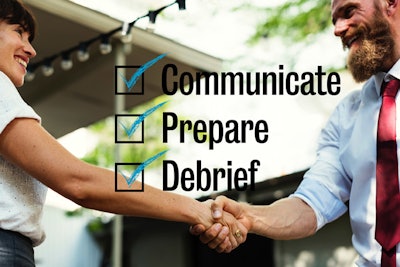
"A happy client trumps all," says Adam Sloyer, C.E.O. of New York-based event agency Sequence.
It's a statement most event professionals would likely agree with, but getting a satisfied client isn't always as simple as executing a beautiful, successful event. Ensuring client happiness is a careful process that starts with the initial pitch meeting and doesn't end until the final debriefing.
Here are some smart ways to improve client-planner relationships before, during, and after an event.
Do your homework before the initial pitch meeting.
“The more feedback and information we have at the onset, the better we can tailor our work styles to fit our clients’ specific needs,” explains Jenny Bronstein, senior vice president of account services for NVE Experience Agency in Los Angeles. “That means it’s just as important for us to relate to our clients on a business level as it is on a personal level. … By thoroughly understanding what motivates our clients—as a brand and as a team of individuals—we can reach creative concepts that will actually help them, which at the end of the day is why they will hire us.”
Sloyer notes the importance of thinking through personality types that will complement each other. “We’ve found that clients are happy when they’re working with a team that meshes well with their style,” he says. “By the time we’re awarded a piece of business, we have a general sense of our clients’ personality, so we look to provide a project team that we feel they’ll be comfortable with. Comfort builds trust, and trust builds relationships.”
Adapt to a client’s communication preferences.
Do the clients prefer phone calls or email? Do they want to be more hands-off, or updated on a regular basis? Get to know your clients’ protocols, communication style, and likes and dislikes. When in doubt, just ask.
“It's important to ask clients how they like to communicate—by phone, meetings, email, or text,” says Danielle Gibson, founder of Danielle Gibson Events in San Francisco. “Personally, I like to keep the email to a minimum and use weekly calls to get all the answers we need.”
Gibson also leans on Google Drive, creating shared documents so clients can have all the files they need in one place—including an event deck in Google Slides that provides every detail with links to outside documents. “This way everything is in one document, so it's easy for everyone to find and follow along,” she notes.
Sloyer also uses organized documents to communicate with clients. “One of our kick-off documents looks to ascertain things like which members of the [client’s] team are involved in the decision-making process, who should be included on what types of correspondence, and preferred method of receiving information.”
Also, make sure to ask about any previous experience the client has had with event agencies and what they liked and disliked about the process. “We try and collect as much data as we can to ultimately customize the experience for them and make sure they’re happy,” says Sloyer.
Check in throughout the planning process.
If a client is more hands-off, you may not need to schedule frequent check-ins, but regular communication during the planning process is still essential to prevent future problems and large changes, says Valerie Combet, owner of Los-Angeles-based event firm Next&Neat.
“Keeping the client involved in the process can help if adjustments are needed along the way,” she explains. “At times, the client may change their mind, and having these stepping stones in place will help facilitate this process and save time.”
Bronstein agrees, noting that she typically assigns a dedicated core project team lead by a seasoned account director. “[That person will] act as a champion of a client’s brand and an extension of their team,” she says.
Bronstein also stresses the importance of sending formal agendas prior to client meetings, as well as post-meeting recaps within 24 hours that detail every decision and action item discussed.
“This ensures the whole project continues on track … and that assets are reviewed in the context of the full program, as opposed to piecemeal in one-off communication,” she explains. “This also ensures key client stakeholders have transparency into when information will be coming and when feedback is expected.”
For more quick-fire, one-off questions, Bronstein likes to create a channel in Slack for general information and file- and idea-sharing.
If a client is unhappy, find out exactly why.
Even if you’re doing everything right, sometimes a client just isn’t responsive to your ideas.
“When we have clients who aren’t seeing what they like, our job is to find out why,” says Sloyer. “For instance, if we’ve presented a round of design concepts and the client doesn’t like any of the ideas, we want to collect specific feedback before we dive into the next round of concepts. What didn’t they like? Were there elements of any ideas that resonated? What were they expecting to see that they didn't? What did we take away from the initial brief that might not have been accurate?”
Keep in mind that some clients are able to articulate their likes and dislikes better than others, so make sure to keep asking for specifics.
Also, make sure the client is clear on how last-minute changes or updates will affect an event’s timetable—and budget. “Everyone changes their mind—just make sure they clearly know how changing their mind can affect the event and the budget,” says Gibson. “Be clear with deadlines and what happens if they miss a deadline—in a professional manner. Be calm, professional, and helpful to everyone involved to rectify the situation.”
Bronstein also stresses the importance of understanding the clear reason behind a client’s decisions. “What are the underlying objectives driving their actions?” she asks. “Often times what they’re asking for and what they actually need are two different things. By empathizing with what’s at the root of their motivations, we can modify our actions and behavior accordingly to accomplish what they actually need.”
The most important thing, according to Bronstein, is to stay nimble and keep a constant flow of communication between teams. Clients need to trust your intentions and ability and know you are fighting for the same ultimate goal.
Learn how involved your client wants to be on event day.
Client relationships on event day will vary depending on the client, host, and type of gathering. Some clients may be more hands-on, while others rely on the agency or planner to take the lead.
“Some clients’ on-site priorities are aligned with ours, and some have other focuses,” explains Sloyer. “Every situation is unique, but preparation is key. Before event day, we want to know what we can do on-site to make the event a success and make ourselves a valuable part of the process.”
One crucial detail: Give your client someone to turn to on event day. “There should be one person who is the main contact with the client,” explains Gibson. “We make sure they understand the details of what we are working on by the minute and share this document with them. We check in during the day periodically to make sure they are happy with everything.”
“If the main contact is leaving for the night or heading to another part of the event, it's always important to say goodnight and tell [the client] who is their contact going forward,” she adds.
Say thank you early and often.
Gibson notes that it's crucial to say goodbye to the client at the end of an event, and thank them for hiring you. “And send an email thanking everyone the next business day,” she says.
Sloyer prefers to take it one step further by writing a hand-written note. "And even more impressive is a custom card that incorporates a few pictures of the event,” he notes.
Make sure to debrief.
Post-event debriefs with a client are a crucial way to figure out what worked well and what didn’t, hopefully leading to repeat business.
“Immediately after an event we begin pulling together a formal executive recap deck for the client to showcase the success of the project through event photos, metrics, and highlight moments,” explains Bronstein. “These presentations also include key learnings that we use to inform a discussion with the client. Post-project dinners, gifts, and presentations aside, the best thank-you we can give our clients is a successful program.”
Sloyer likes to start debriefings by first talking about the big picture, and then diving into the nitty-gritty details. “This allows us to categorize and prioritize feedback, ensuring more important achievements or challenges don’t get lumped in with lesser ones,” he says. “Even if an event is a one-off, a debrief can be used for other events, or as an opportunity to present key findings to senior management.”
Combet notes that depending on the client, a debriefing does not always have to be a formal process. “We will instead invite our client for a casual lunch a few days later after giving everyone some rest from the event,” she explains. “We believe that creating a bonding experience with our client is the key for a continued successful relationship in our business.”
Remember that a great event does not automatically mean a client is happy.
“We can produce an event that is incredibly creative, well-executed, delivers results, et cetera—but if for whatever reason the client isn’t happy, we’re likely not getting rehired,” says Sloyer. “Alternatively we can produce an event that might not be perfect, but if the client is happy we as an agency are in a good place. Often times there’s a strong correlation between a happy client and a successful event—but not always.”



















